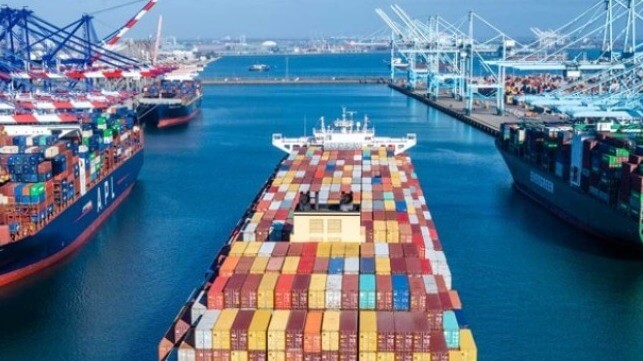Container Rates Continue to Fluctuate While Charters Move Higher

Container shipping rates continue to be highly volatile as the industry moves towards a traditionally slower period during the Lunar New Year celebrations and a traditional easing of volumes in the subsequent months before it increases as the industry moves toward summer. While there have been signs in recent weeks of an easing on Pacific spot rates to the United States, charters of box ships are now reported to again paying record increases continuing the wild fluctuations be seen in the market of the past year.
New data from Shifl, a digital freight forwarding platform, shows that spot freight rates for containers moving from Chinese ports to Los Angeles and New York have fallen in the runup to and following the Chinese New Year. Shifl’s data suggests that container spot rates peaked in the August to September 2021 time frame and again around the beginning of 2022.
"2021 has seen historically high spot rates as the ripple effect of the COVID disruption, increased demand and blank sailings continued to wreak havoc on the supply chain. Shippers struggled to book freight as the demand was considerably higher than the carrier and port capacity" said Shabsie Levy, CEO and Founder of Shifl. "While rates have been extremely volatile, the prices started to cool down as we head into the traditionally low peak season, vessels returning from LA/Long Beach and customers reporting lower demand in sales."
While spot rates might have temporarily softened, analysts point to new peaks in charter rates which will likely contribute to more volatility in the spot market and likely further significant increases for new long-term contracts.
Alphaliner highlighted this week that its rate index for charters hit a new historic high. They indicated in some categories that are seeing rates up by as much as a third and with tonnage expected to remain short supply for much of 2022 rates are expected to continue to see upward pressure in the market.
London-based owner and charter of containerships, Global Ship Lease updated investors yesterday reporting “We have also remained active in chartering, securing long-term employment for our only near-term expiry, the Kumasi, and exploring opportunities for forward contracts for vessels coming off charter later this year.” They are reporting that the rates achieved represented an increase of more than 300 percent from the vessel’s prior rate and are approximately 20 percent higher than multi-year charters for two sister vessels during the fourth quarter of 2021. “We believe that this is clear evidence that the market for mid-sized and smaller containerships has maintained significant positive momentum on the back of highly supportive and durable fundamentals despite what is traditionally the low season for the charter market.”
Market conditions continue to also apply pressure on the rates. Shifl highlights that transit time from Chinese ports to the U.S. West Coast remains spectacularly high recently at 44 days versus 16 days that was the norm pre-pandemic. Similarly, transit times between Chinese ports and New York remain high at 38 days in the first half of January 2022, which while unchanged since mid-2021 is up from previous levels of 27 days.
The only good news for shippers is that the times for containers at the major ports on the West and East Coast have been on the decline since December. Shrinking gate out times, Shifl says represent returning balance in landside operations and might be a forward indicator of vessel transit times. Quicker gate out times they believe will inevitably lead to terminals unloading vessels faster, in turn reducing idle time for vessels and lowering transit times.
While the hope is that these factors might have a calming effect on rates, near term there is no sign of a let-up in volumes. The Marine Exchange for Southern California reports that there are 92 containerships registered and currently slow steaming in the Pacific toward the ports of Long Beach and Los Angeles. The first decrease in traffic, if the comes, might be in mid-February as operations pause briefly for the Lunar New Year. However, with many warehouse inventories still low and supply chains strained it is likely the volumes will pick up for critical goods after the brief pause during the holiday.
